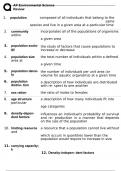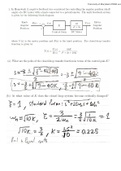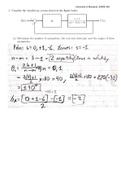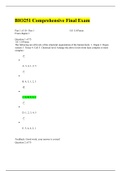Percent overshoot - Study guides, Class notes & Summaries
Looking for the best study guides, study notes and summaries about Percent overshoot? On this page you'll find 16 study documents about Percent overshoot.
Page 2 out of 16 results
Sort by

-
Bio 171 Week 2 (Vocab and guiding questions) questions and answers |A+ content
- Exam (elaborations) • 5 pages • 2023
- Available in package deal
-
- $7.99
- + learn more
Bio 171 Week 2 (Vocab and guiding questions) questions and answers |A+ content Ecology the branch of biology that deals with the relations of organisms to one another and to their physical surroundings. Emigration movement out of a population Exponential Growth Growth pattern in which the individuals in a population reproduce at a constant rate, without the carrying capacity taken into account geographic range the area over which a population is spread (reflects in part...

-
AP Environmental Science Review
- Exam (elaborations) • 89 pages • 2023
-
- $13.99
- + learn more
1. population composed of all individuals that belong to the same species and live in a given area at a particular time 2. community incorporates all of the populations of organisms within a given area 3. population ecolo- gy the study of factors that cause populations to increase or decrease 4. population size the total number of individuals within a defined area at a given time 5. population densi- ty 6. population distriu- tion the number of individuals per unit area (or v...

-
Old Homework 4 Winter 2019 - Vibrations, Controls and Optimization 2
- Other • 12 pages • 2021
- Available in package deal
-
- $2.99
- + learn more
This is an old homework/assignment from the course; Vibrations, Controls and Optimization 2. The topics covered in this homework include; negative feedback, unity feedback, close loop transfer function, control gain, system damping, settling time, damped frequency, percent overshoot, s plane, second-order system poles, peak response, system response, unit step input, damping ratio, natural frequency, and second-order pair of poles.

-
Old Homework 5 Winter 2019 - Vibrations, Controls and Optimization 2
- Other • 10 pages • 2021
- Available in package deal
-
- $2.99
- + learn more
This is an old homework/assignment from the course; Vibrations, Controls and Optimization 2. The topics covered in this homework include; controller gain, percent overshoot, unit step input, steady-state value, block diagram reduction, unity feedback, settling time, steady-state error, damping ratio, and natural frequency,

-
Old Homework 8 Winter 2019 - Vibrations, Controls and Optimization 2
- Other • 15 pages • 2021
- Available in package deal
-
- $2.99
- + learn more
This is an old homework/assignment from the course; Vibrations, Controls and Optimization 2. The topics covered in this homework include; close loop system, asymptotes, real axis intercepts, real axis intercepts, break-in points, break out points, root locus, stability, K value, zeroth row, unity feedback, control functions, Laplace domain, complex roots, RH method, compensator, control gain, characteristic equation, root locus standard form, transfer function, percent overshoot, settling time, ...

-
BIOS 251 Comprehensive Final Exam | BIO 251 Comprehensive Final Exam with Verified answers-100% correct.
- Exam (elaborations) • 60 pages • 2020
-
- $14.79
- 2x sold
- + learn more
BIO251 Comprehensive Final Exam Part 1 of 10 - Part 1 5.0/ 5.0 Points From chapter 1 Question 1 of 75 1.0/ 1.0 Points The following are all levels of the structural organization of the human body: 1. Organ 2. Organ system 3. Tissue 4. Cell 5. Chemical level Arrange the above levels from least complex to most complex: • A. 3, 4, 1, 2, 5 • B. 4, 5, 1, 2, 3 • C. 5, 4, 3, 1, 2 • D. 1, 2, 3, 4, 5 • E. 5, 4, 6, 2, 1 Feedback: Good work; your answer is...

Did you know that on average a seller on Stuvia earns $82 per month selling study resources? Hmm, hint, hint. Discover all about earning on Stuvia


